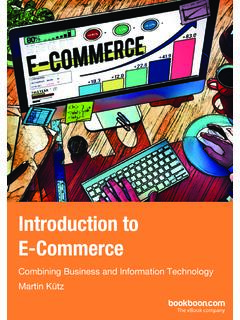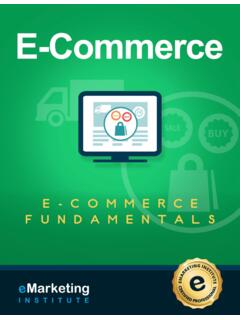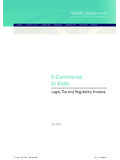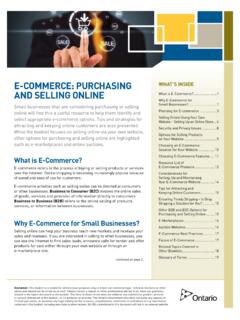Transcription of How COVID-19 Unlocked the Adoption of E-commerce in …
1 How COVID-19 Unlocked the Adoption of E-commerce in the MENA Region FOR DEVELOPMENT &. ENTREPRENEURSHIP. Contents Executive summary 3. Introduction 5. COVID-19 and E-commerce : A growing power or a temporary momentum? 6. Insight 1: COVID-19 accelerated the growth of an already thriving E-commerce sector 6. Insight 2: The E-commerce boom created a ripple effect across logistics and fintech 13. Insight 3: Resilient supply chains need greater localization 15. Insight 4: Decreased dependence on cash on delivery requires building trust 16.
2 Insight 5: Conversational commerce and super apps are opening new E-commerce markets 19. What did COVID-19 show us? 21. Recommendation 1: Transform the trust-based economy 21. Recommendation 2: Foster entrepreneurship ecosystems 22. Recommendation 3: Create unified markets 23. Recommendation 4: Promote digitization & technology Adoption 23. Conclusion 24. Annex I - Methodology 25. Acknowledgements 27. Endnotes 28. Executive summary When the COVID-19 pandemic aforementioned markets. The began to affect global markets, it Legatum Center for Development became clear that it would test and Entrepreneurship at MIT and the resilience and performance Wamda conducted interviews of a rapidly growing E-commerce and conversations with over sector in the Middle East and 40 industry players resulting North Africa (MENA) region.
3 In several key insights and This was especially true in the recommendations with regards to United Arab Emirates (UAE), how E-commerce might continue The Kingdom of Saudi Arabia to advance in the current (KSA), and the Arab Republic of landscape and future. Egypt, the three focus markets of the research conducted. This paper takes a close look at how the pandemic impacted the growth and resilience of the E-commerce space in these three Wamda - MIT Legatum Center 3. KEY INSIGHTS INCLUDE: KEY RECOMMENDATIONS. INCLUDE: 1. COVID-19 accelerated the growth of an already thriving 1.
4 Implement more robust E-commerce sector. policies to transform the trust-based economy and 2. The E-commerce boom protect customers from created a ripple effect across fraud. logistics and fintech. 2. Invest in developing 3. Resilient supply chains need small business hubs for greater localization. E-commerce . 4. Decreased dependence 3. Coordinate a unified customs on cash on delivery (COD). market. requires building trust. 5. Conversational commerce 4. Increase efforts to promote and super apps are opening digitization and technology new E-commerce markets.
5 Adaptation that allow more people to participate in the Maintaining the momentum economy. created by COVID-19 , however, requires government players to As E-commerce develops, these implement strategies that can efforts will help push economies now capitalize on the growth of to be more inclusive, while also the sector. growing economic opportunities across the region. Wamda - MIT Legatum Center 4. Introduction Before the pandemic, MENA's E-commerce sector was one of the fastest-growing in the world Although it accounted for just 2 percent of the retail market in the region, the E-commerce sector doubled in size from Early reports indicated that $ billion in 2015 to $ billion by 2017.
6 E-commerce in the Middle East is This was due to a rapid rise in internet winning the pandemic penetration, the arrival of 4G, and a young population comfortable with making such drastic economic changes, the closed purchases Today, 80 percent of young shop signs for many retailers became Arabs shop online frequently, compared to permanently closed . This presented an 71 percent in In addition, 50 percent opportunity for online commerce in the of those aged 18-24 in MENA are shopping region, as consumers switched to buying more online after the pandemic.
7 As a result, their goods online. The pandemic resulted in the sector reached a value of $22 billion by a shift that accelerated this projected growth, the end of 2020. [see Figure 3].iii as early reports indicated that E-commerce in the Middle East is winning the pandemic. The bulk of growth in the sector was driven by the UAE, Saudi Arabia, and Egypt, which Looking to identify strategies to capitalize together account for 80 percent of the on this momentum, the Legatum Center for region's overall E-commerce market. The Development and Entrepreneurship at MIT.
8 UAE's digital economy prior to COVID-19 . and Wamda joined forces to study how the contributed percent to the country's gross pandemic affected the E-commerce sector in domestic product (GDP). In addition, the MENA [see Annex I for Methodology]. E-commerce industry in the country is set to reach $ billion by 2023, according to the With the dramatic growth in the sector, Dubai Future Foundation. In Saudi Arabia, the E-commerce presents opportunities industry projected a market volume of $ to transform the fundamental ways billion by that economies work by reshaping consumer preferences and conventions The coronavirus pandemic was the defining in logistics infrastructure.
9 This tech-driven event of 2020. Global attempts to stymie the transformation has the power to build pandemic's impact have disrupted, refined, ecosystems that invite small, local businesses and repurposed business and consumer into the value chain, while the momentum of practices alike. Brick and mortar commerce E-commerce can drive the growth needed in was among the worst-hit as a result of the the region. lockdowns that swept across the world. MENA saw substantial declines in footfall and stricter controls imposed at borders. Unfortunately, as shops could not weather Wamda - MIT Legatum Center 5.
10 COVID-19 and E-commerce : A growing power or a temporary momentum? Insight 1: COVID-19 accelerated the growth of an already thriving E-commerce sector Within a short time span, companies that delayed digitization shifted to meet consumers online. At the same time, new consumers came on board with minimal effort from companies, to access and purchase their essential needs. PRE-PANDEMIC. E-commerce has been the cornerstone of In addition, investors in MENA have entrepreneurship in MENA and has served traditionally felt more comfortable backing a critical role in enabling the overall startup E-commerce and marketplace startups, and ecosystem.





